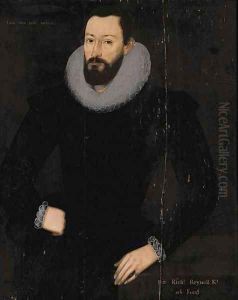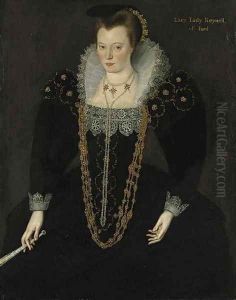Marcus The Younger Gheerhaerdts Paintings
Marcus Gheerhaerdts the Younger, born in 1561 in Bruges, was a prominent Flemish painter, engraver, and draughtsman known for his contributions to the Northern Renaissance art movement. His family was deeply entrenched in the arts; his father, Marcus Gheeraerts the Elder, was also a celebrated artist, providing a richly creative environment for his upbringing. This familial background laid the foundation for Gheerhaerdts's artistic career, fostering his development and eventual mastery of the arts from a young age.
In the late 16th century, amidst the turbulent socio-political climate of the Spanish Netherlands, Gheerhaerdts moved to England. This relocation was partly due to the increasing tensions and persecution faced by Protestants in the Low Countries, which drove many artists, intellectuals, and religious refugees to seek a new life abroad. In England, he became closely associated with the court of Queen Elizabeth I, which marked the beginning of a prosperous period in his career. His work during this time gained recognition for its intricate detail, sophisticated use of allegory, and the portrayal of the Elizabethan court's opulence. He is perhaps best known for his portrait work, which played a significant role in shaping the visual iconography of the Elizabethan era. Among his notable works is the 'Ditchley Portrait' of Queen Elizabeth I, celebrated for its symbolic complexity and portrayal of the queen within a cosmic and terrestrial landscape, highlighting her power and divine right to rule.
Gheerhaerdts's contributions to the arts extended beyond painting to include engravings and drawings, demonstrating his versatility and skill across multiple mediums. His work not only reflects the artistic and cultural zeitgeist of the Elizabethan period but also provides valuable insights into the socio-political narratives of his time. Through his portraits and allegorical compositions, he captured the essence of an era marked by exploration, intellectual expansion, and the consolidation of monarchical power.
Marcus Gheerhaerdts the Younger's legacy is characterized by his ability to blend Flemish artistic traditions with the emerging styles of the English Renaissance, creating a unique visual language that resonated with the aristocratic and intellectual elite of his adopted country. His death in 1635 marked the end of a distinguished career, but his influence persisted, contributing to the evolution of portrait painting in England and the broader narrative of Renaissance art. Today, his works are preserved in several major museums and collections, serving as a testament to his artistic prowess and the cultural exchange between the Low Countries and England during a pivotal period in European history.

